
In AD200 Indian traders followed the monsoon winds eastward to Southeast Asia, where they traded their goods with China, Europe and Champa (modern day Vietnam). Once in the Mekong Delta, they would have to wait up to six months until the winds reversed for passage back to India.
 While waiting the Indian traders travelled up the monsoon flooded Mekong River (see map right) to the northern shores of Tonle Sap and future site of Angkor. The Indian traders (whose civilization had been highly developed several hundreds of years earlier), brought their knowledge as well as religious and cultural beliefs to the people of the Funan (Pre-Angkor Era) 1st Century - 613. This significantly aided the development of this native kingdom.
While waiting the Indian traders travelled up the monsoon flooded Mekong River (see map right) to the northern shores of Tonle Sap and future site of Angkor. The Indian traders (whose civilization had been highly developed several hundreds of years earlier), brought their knowledge as well as religious and cultural beliefs to the people of the Funan (Pre-Angkor Era) 1st Century - 613. This significantly aided the development of this native kingdom.
 Chenla (called by Chinese or "Kambuja" by Khmer, was a more direct ancestor of the Khmer Empire. In the year AD550, it would become a vassal state, gaining independance from the Funan Kingdom. During the next 60 years, Chenla would successfully conquer its predecessor the Funan, and slowly absorb its people as well as inherit its Indian cultures. Later Chenla would become divided into two states (see map on left). "Chen-la of Land" (modern Laos) would retain some stability, yet "Chen-la of Land" (modern Cambodia) would shatter into no less than 5 smaller states, all of which came under the domination of Java by the end of the 8th century.
Chenla (called by Chinese or "Kambuja" by Khmer, was a more direct ancestor of the Khmer Empire. In the year AD550, it would become a vassal state, gaining independance from the Funan Kingdom. During the next 60 years, Chenla would successfully conquer its predecessor the Funan, and slowly absorb its people as well as inherit its Indian cultures. Later Chenla would become divided into two states (see map on left). "Chen-la of Land" (modern Laos) would retain some stability, yet "Chen-la of Land" (modern Cambodia) would shatter into no less than 5 smaller states, all of which came under the domination of Java by the end of the 8th century.
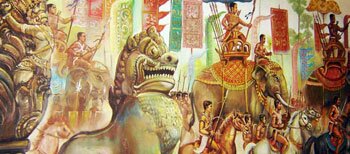 In AD790 Jayavarman II began his quest to conquer and unite what was previously "Chenla of Water". He became king of a kingdom called "Kambuja", and established his new capital near the modern town of Rolous, where he would begin the groundwork for Angkor, which was to be built 15 km to the northwest. In 802 he had a Brahman priest declare him 'Chakravartin' (meaning 'supreme world emperor'), in a ritual taken from the Indian-Hindu tradition,
In AD790 Jayavarman II began his quest to conquer and unite what was previously "Chenla of Water". He became king of a kingdom called "Kambuja", and established his new capital near the modern town of Rolous, where he would begin the groundwork for Angkor, which was to be built 15 km to the northwest. In 802 he had a Brahman priest declare him 'Chakravartin' (meaning 'supreme world emperor'), in a ritual taken from the Indian-Hindu tradition,  which would eventually unify the people and firmly be recognized as the founder of the Khmer Empire.
which would eventually unify the people and firmly be recognized as the founder of the Khmer Empire.
From the 9th to the 15th century including Jayavarman II, there were a total of 38 kings that ruled the Khmer Empire. Each king would build his own monument in his glory including the most famous of all temples Angkor Wat, the single largest religious monument in the world. The temple is a huge pyramid structure with the compound covering 1,300 by 1,500 metres in size. Built over 32 years by 50,000 workers under the reign of King Suryavarman II (1113 – 1150), Angkor Wat stands taller than Notre Dame Cathedral at 214 ft in height and has more stone than the Great Pyramid of Giza in Egypt.
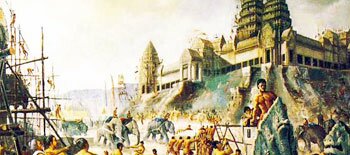 The Khmer regarded their rulers as "Gods on Earth", and Angkor Wat (dedicated to the Hindu god Vishnu), was built to represent the Hindu Universe. Along the causeway leading to the enormous gate entrance are balustrades shaped as giant serpents, which are believed to
The Khmer regarded their rulers as "Gods on Earth", and Angkor Wat (dedicated to the Hindu god Vishnu), was built to represent the Hindu Universe. Along the causeway leading to the enormous gate entrance are balustrades shaped as giant serpents, which are believed to
represent emblems of cosmic fertility. The temple consists of a towering complex surmounted by five lotus-shaped towers in the centre that symbolizes Mt. Meru, the celestial home of the gods, and the huge surrounding moat 180 metres wide, the vast cosmic oceans.
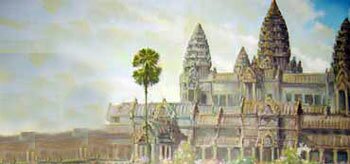 Angkor Wat became the most elaborate and greatest achievement of Khmer temple architecture in the empire with its covered walls of carved relief's illustrating Hindu mythology. Today Angkor Wat is considered the "flagship" of all temples at Angkor.
Angkor Wat became the most elaborate and greatest achievement of Khmer temple architecture in the empire with its covered walls of carved relief's illustrating Hindu mythology. Today Angkor Wat is considered the "flagship" of all temples at Angkor.
Over the centuries the kings of the Khmer Empire fought many wars 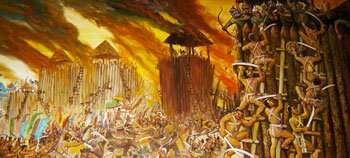 with their rivals in the region. The Khmer empire was temporarily overthrown (1165 – 1177) in a naval battle on Tonle Sap by the Champa (modern day Vietnam) army, until the future king, Jayavarman VII gathered an army and regained the empire.
with their rivals in the region. The Khmer empire was temporarily overthrown (1165 – 1177) in a naval battle on Tonle Sap by the Champa (modern day Vietnam) army, until the future king, Jayavarman VII gathered an army and regained the empire.
 After becoming king, Jayavarman VII continued the war with the
After becoming king, Jayavarman VII continued the war with the
Champa for 22 years until he conquered large areas of their kingdom. He became known as the last of the great kings of Angkor due to his military fortitude, and because he unified the empire and
completed more building projects than all the previous kings combined. Angkor Thom (meaning; "Great City") was a 3 km squared walled and moated royal city with 5 gates (most famous being the "Victory Gate" which led to the Royal Palace area) that was built and established as the capital of Jayavarman VII's empire. He would also build the state-temple of Bayon (with 37 standing towers, most but not all sporting four carved faces), an extensive network of streets which connected every town in the empire, as well as rest houses and hospitals.
The Khmer Empire flourished in the 13th century under the reign of Jayavarman VII until his death in 1219. The Khmer would eventually retreat from previously conquered Champa (modern day Vietnam) as well as endure a rebellion in the west (modern day Thailand), that seen the creation of the 1st Thai Kingdom of Sukhothai.
Instability in the empire over the following century magnified with future kings converting from Buddism to Hinduism, destroying an estimated 10,000 temples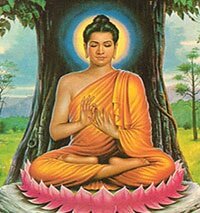 . The empire was even threatened by the Mongols under the great Kublai Khan, but war was avoided by paying tribute to Khan and China on a yearly basis.
. The empire was even threatened by the Mongols under the great Kublai Khan, but war was avoided by paying tribute to Khan and China on a yearly basis.
By the 14th century Theravada Buddism emerged, a new school of Buddism, which was spreading throughout the Southeast regions of Asia and Sri Lanka. The decline and end of Angkor after 1327 is believed to be because of the adoptions of the new school of Buddism and the subsequent loss of royal authority and lack of workers. The complex water management system began to fail due to long droughts and loss of valuable harvests.
In AD1389 the Thai's attacked Angkor, and the city fell into their hands. The 15th-century conquest of the Khmer kingdom by The Kingdom of Siam resulted in the final abandonment of Angkor in 1431. The city was looted and enslaved, and eventually deserted with the capital moving eastward to what is now Cambodia's modern day capital of Phnom Penh.
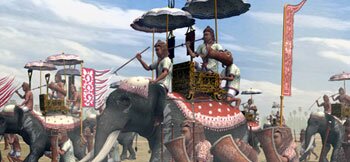 Ancient Angkor was said to be the largest pre-industrial city in the world, with an expansive infrastructure that connected an ancient metropolis upwards of 1,000 sq km. The elaborate water management system supported an estimated population of 750,000 to 1 million people at its zenith, making it the largest urban sprawl in the world.
Ancient Angkor was said to be the largest pre-industrial city in the world, with an expansive infrastructure that connected an ancient metropolis upwards of 1,000 sq km. The elaborate water management system supported an estimated population of 750,000 to 1 million people at its zenith, making it the largest urban sprawl in the world.
Located almost 320 km to the North-West of Cambodia's modern day capital of Phnom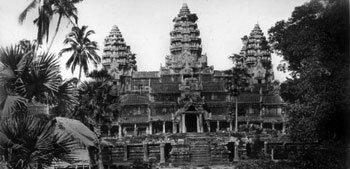 Penh, Angkor is one of the most mysterious and beautiful historical sites in the world. Isolated and surrounded by thick jungle, Angkor sat hidden from the western world for centuries until westerners came across the temples in the 16th Century. Archeologists in the 19th Century would begin to explore Angkor (pictured above), discovering and deciphering ancient scripts on the temples and stone sculptures that started to piece together the history of this "Lost World" of the
Penh, Angkor is one of the most mysterious and beautiful historical sites in the world. Isolated and surrounded by thick jungle, Angkor sat hidden from the western world for centuries until westerners came across the temples in the 16th Century. Archeologists in the 19th Century would begin to explore Angkor (pictured above), discovering and deciphering ancient scripts on the temples and stone sculptures that started to piece together the history of this "Lost World" of the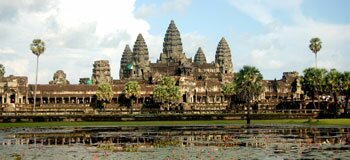 Khmer Empire. Many leading historians believe that the rise and subsequent fall of the Khmer Empire (Southeast Asia's most powerful between the 9th and 14th centuries) was due to the great success and then failure of it's complex water management system.
Khmer Empire. Many leading historians believe that the rise and subsequent fall of the Khmer Empire (Southeast Asia's most powerful between the 9th and 14th centuries) was due to the great success and then failure of it's complex water management system.



